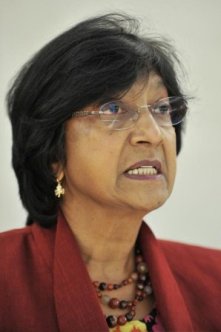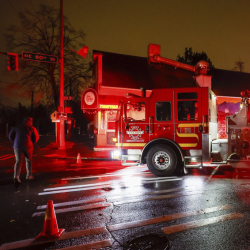
|
The death toll in devastated Syria has now surpassed an estimated 60,000 people, the United Nations said Wednesday, a dramatic figure that could skyrocket if the all-out civil war persists.
The toll is comparable to the latest population estimates of a small U.S. city such as Cheyenne, Wyoming. or the capacity of a packed sports stadium. And it's "truly shocking" and shameful, said U.N. High Commissioner for Human Rights Navi Pillay, who blamed the international community for inaction.
"Collectively we have fiddled at the edges while Syria burns," she said. "While many details remain unclear, there can be no justification for the massive scale of the killing highlighted by this analysis," she said.
Echoing the fears of U.N.-Arab League envoy Lakhdar Brahimi, Pillay predicted more deaths "Unless there is a quick resolution to the conflict."
"I fear thousands more will die or suffer terrible injuries as a result of those who harbor the obstinate belief that something can be achieved by more bloodshed, more torture and more mindless destruction," she said.
Death estimates have varied among opposition groups who have issued daily counts. For example, the Syrian Observatory for Human Rights says more than 46,000 people have died since March 2011.
U.N. data specialists counted 59,648 individuals reported killed in Syria between March 15, 2011, and November 30, 2012, Pillay said. Scores of deaths have been reported every day in December.
One opposition group reported more than 150 deaths on Wednesday, including more than 70 people killed during an air raid in the Damascus suburbs.
Pillay said the number of deaths is higher than expected.
"This massive loss of life could have been avoided if the Syrian government had chosen to take a different path than one of ruthless suppression of what were initially peaceful and legitimate protests by unarmed civilians," Pillay said.
"As the situation has continued to degenerate, increasing numbers have also been killed by anti-government armed groups, and there has been a proliferation of serious crimes including war crimes, and -- most probably -- crimes against humanity, by both sides.
She also said that the 60,000 "is likely to be an underestimate of the actual number of deaths."
"The recording and collection of accurate and reliable data has grown increasingly challenging due to the conflict raging in many parts of the country," she said.
"Once there is peace in Syria, further investigations will be necessary to discover precisely how many people have died, and in what circumstances, and who was responsible for all the crimes that have been committed."
Pillay cited air attacks, shelling, tank fire, bomb attacks, street-to-street fighting and sectarian fighting. There have been increases in deaths during the conflict from 1,000 per month in the summer of 2011 to more than 5,000 per month since July, she said.
The greatest number of killings have occurred in Homs, the Damascus outskirts, Idlib, Aleppo, Daraa, and Hama. More than three-quarters of the victims are male and 7.5% are female, Pillay said. The gender of the others aren't clear, and analysts couldn't "differentiate clearly between combatants and non-combatants."
She said the inability of the U.N. Security Council and the international community to stop the violence "shames us all."
"We have been repeatedly asked: 'Where is the international community? Why aren't you acting to stop this slaughter?' We have no satisfactory answer to those questions," she said.
She said there must be plans to stave off instability after the conflict ends. Afghanistan, Iraq, Somalia and the Democratic Republic of the Congo experienced problems because transition from dictatorship to democracy "was given insufficient support," she said.
Syrian air power
Syrian government warplanes hammered the Damascus suburbs and other targets Wednesday and left dozens dead in an airstrike on a fuel station.
The fighting raged as President Bashar al-Assad's government worked to ramp up its air attacks and rebels targeted air bases.
At least 74 people died and dozens were wounded in the Damascus suburb of Mleiha in the fuel station air raid, the opposition Local Coordination Committees of Syria said, citing initial reports.
"The number of martyrs is likely to be increased due to continuous pulling of the bodies from under the rubble," the LCC said.
The victims were among 151 people killed in the country on Wednesday, most of whom died in Damascus and its suburbs.
Aerial shelling was reported in the Damascus suburb of Harasta, in the cities of Aleppo and Deir Ezzor and other locations.
Rebels fight for an airbase
In Idlib province, Syrian rebels, including jihadists, fought to wrest a key military air base from government forces Wednesday, the opposition said, as anti-regime fighters kept up the heat on al-Assad's forces.
Al-Nusra Front, a militant group that the United States designated last month as a terrorist movement, is among three rebel factions attacking the Taftanaz military air base, rebels said in a statement.
"The battle to liberate Taftanaz military airport has started," the rebels said. "Taftanaz airport has been delivering horrors to Muslims. The warplanes fly from there on a daily basis, to throw explosive barrels on villages and towns."
The other factions are Battalions of Ahrar Al-shaam and the Islamic Forefront. Ahrar is an Islamist coalition with some Salafist elements that cooperates with the Free Syrian Army. The Islamic Forefront is a larger umbrella group of Islamist organizations; one of its members is Ahrar.
About 400 soldiers are based at the airport, along with a number of pro-government militia members.
At the base are 30 planes, including transportation craft and fighting jets; seven armored vehicles, including tanks and armored personnel carriers; artillery and rocket launchers.
Casualties have been reported on both sides in the fighting, but precise numbers were not available.























































































































































































































































































































































